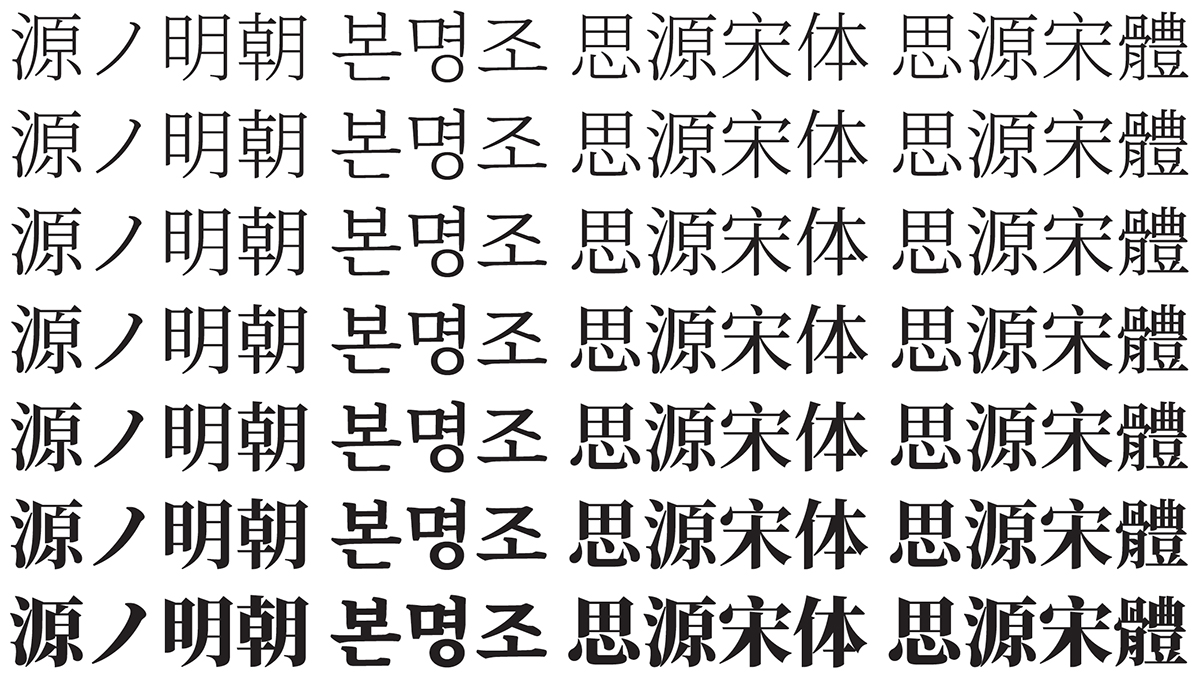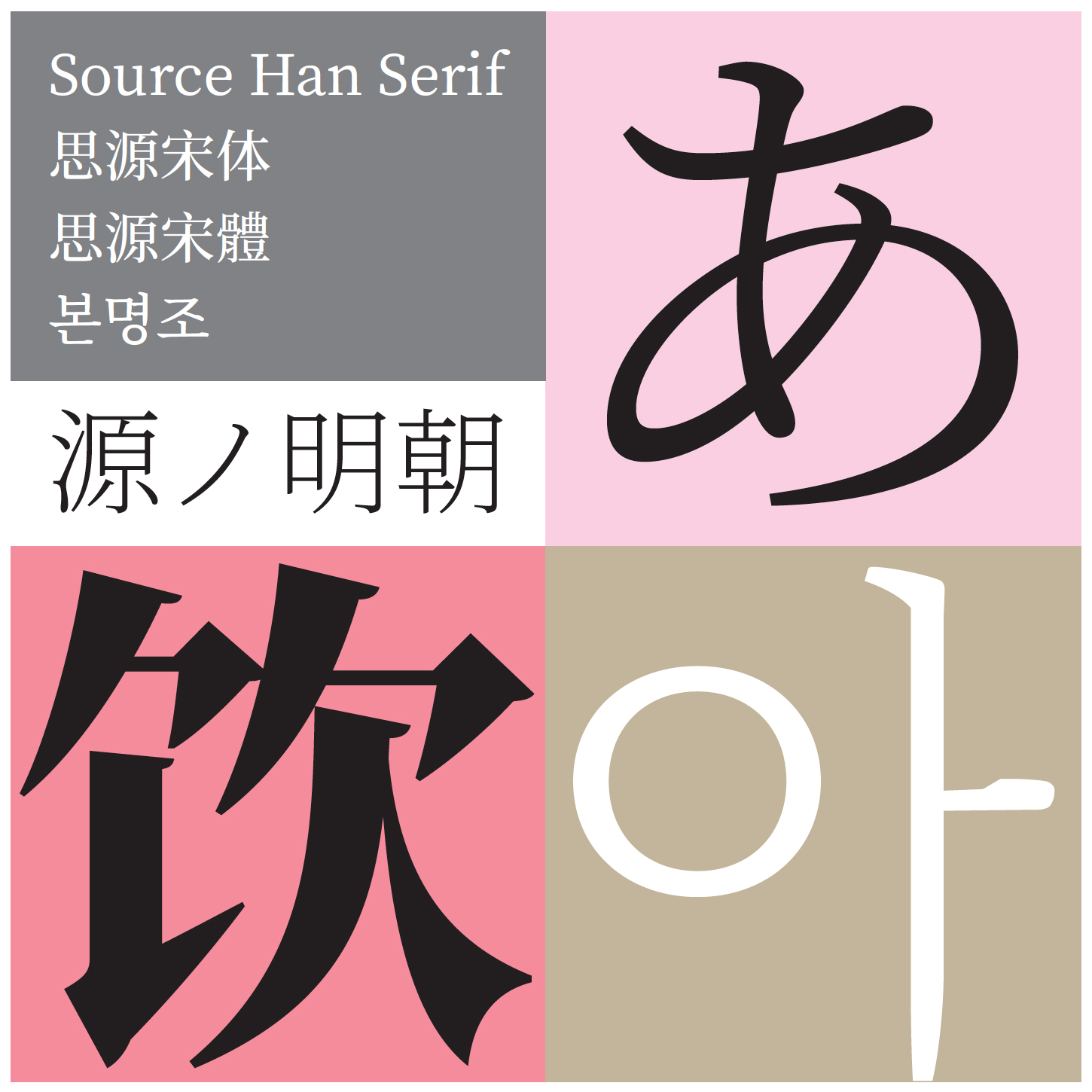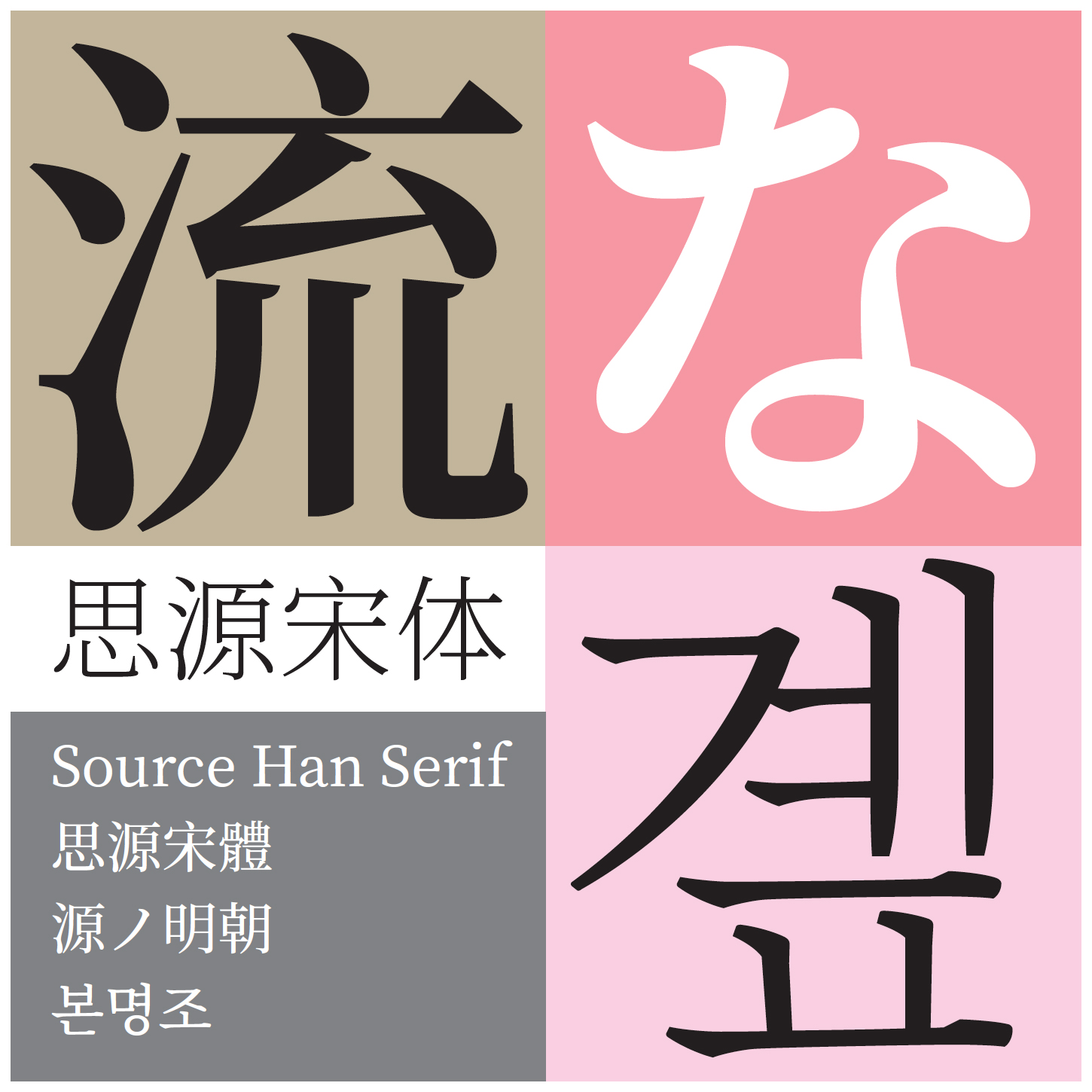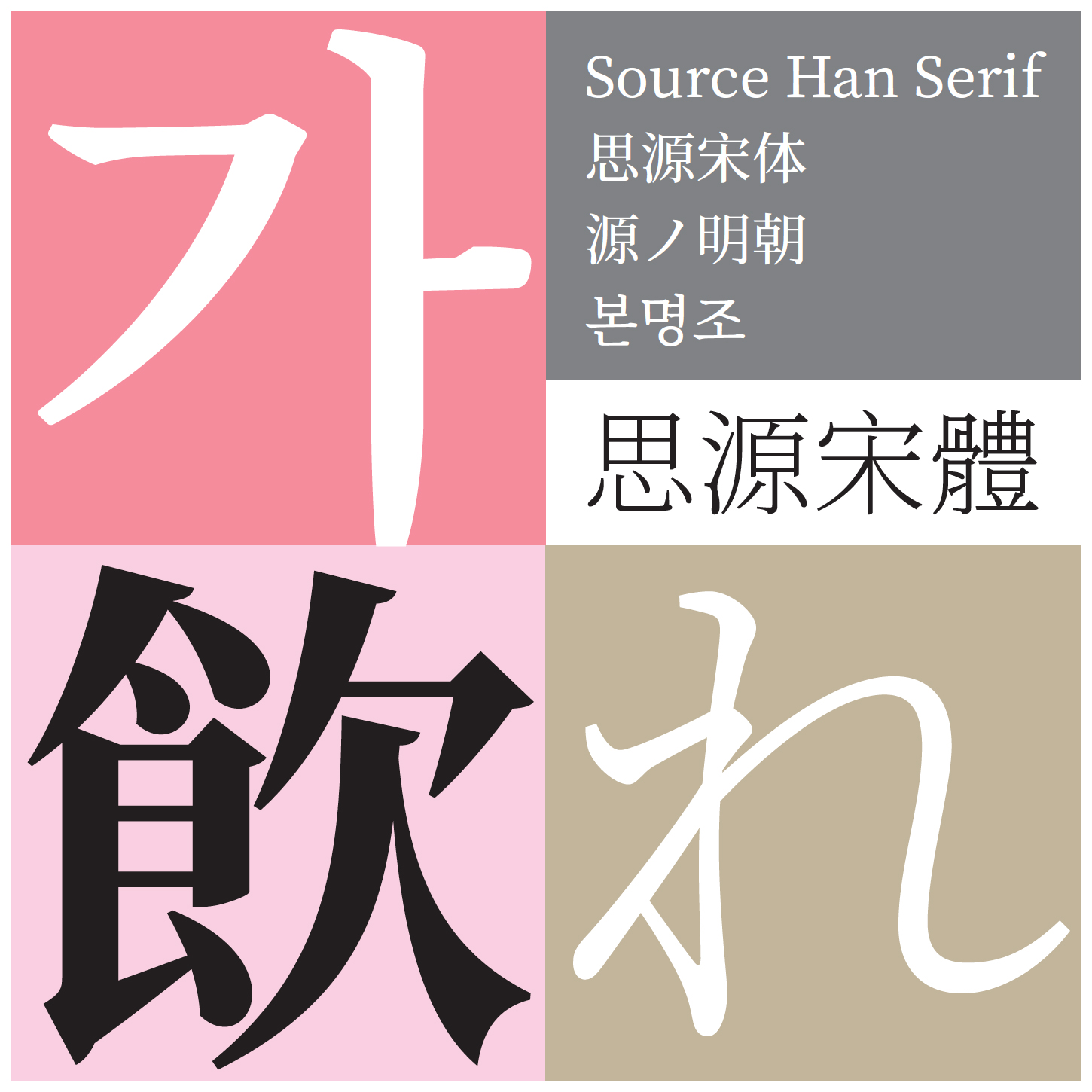
Or, perhaps more accurately, the project that has been keeping me busy for the past couple of years.
The Adobe-branded Source Han Serif (named 源ノ明朝 in Japanese, 본명조 in Korean, 思源宋体 in Simplified Chinese, and 思源宋體 in Traditional Chinese) and Google-branded Noto Serif CJK open source Pan-CJK typeface families, which represent the serif-style counterparts to the similarly-named and also open source Source Han Sans and Noto Sans CJK Pan-CJK typeface families, were released on 2017-04-03. You can read more about the Source Han Serif release here (日本語—한국어—简体中文—繁體中文), which includes a six-minute promotional video.
This article provides information that you would not expect to find in the official announcements for Source Han Serif or Noto Serif CJK, mainly because such information is intended for a completely different audience, which is primarily comprised of font developers.
Unless noted otherwise, all further references to Source Han Serif or Source Han Sans will apply to Noto Serif CJK or Noto Sans CJK, respectively.
Development Timeline
The actual design work for Source Han Serif began in late 2014, a few short months after the release of Source Han Sans, initially in the form of fine-tuning most of the JP glyphs that correspond to Adobe-Japan1-6 kanji. Iwata began designing the glyphs for the additional JP ideographs, along with those for the small number of KR ideographs, in early 2015. Changzhou SinoType began designing the Chinese glyphs in mid-2015. Sandoll’s designer, Soohyun Park (박수현), first needed to develop the Hangul Element Library, which was tedious work that took months, and which was subsequently used as the basis for designing the glyphs for the hangul letters, symbols, and syllables. Finally, Adobe’s own Frank Grießhammer provided additional Source Serif glyphs that were necessary.
I prepared six interim builds during the development period, with each successive one adding more glyphs and functionality. The table below provides the date associated with each interim build, the number of glyphs per weight, and significant details.
| Interim Build | Date | Glyphs | Details |
|---|---|---|---|
| First | 2015-09-21 | 26,166 | All JP and KR ideographs, initial CN ideographs, three weights, glyphs ordered by type foundry |
| Second | 2016-01-29 | 38,836 | Additional CN ideographs, initial hangul syllables, nine weights |
| Third | 2016-05-27 | 52,277 | Additional CN ideographs, additional hangul syllables, initial TW ideographs, seven weights |
| Fourth | 2016-08-26 | 57,359 | Additional CN and TW ideographs, additional hangul syllables, initial HK ideographs |
| Release Candidate 1 | 2016-12-19 | 64,665 | Additional hangul syllables, combining jamo, CJK (Japanese kana and punctuation) kerning, glyph-complete |
| Release Candidate 2 | 2017-02-27 | 65,535 | Western kerning, glyph reordering, separate Source Han Serif and Noto Serif CJK font resources |
The interim builds were a very important part of the overall development process, because they provided to Adobe, Google, and our foundry partners—Sandoll Communications, Iwata, and Changzhou SinoType—an opportunity to review the glyphs in mixed-script and mixed-language contexts. Various adjustments were made, sometimes to entire scripts, as a result of each review cycle.
In addition to thanking our three foundry partners and Adobe’s own talented designers for all of their hard work that culminated into a finished product, I would like to extend special thanks to one person in particular. On behalf of Adobe, Google, and the incredibly large number of users that span the globe, I would like to use this opportunity to call out and personally express my sincere gratitude to Eric Q Liú for his valuable feedback, which resulted in a higher-quality typeface design. 谢谢!
Development Details
In addition to being modeled after our success with Source Han Sans, Source Han Serif represented an opportunity to keep up with new characters in Unicode, and to explore new techniques, efficiencies, and functionality.
In terms of Unicode, URO (Unified Repertoire & Ordering) coverage is now complete through Unicode Version 10.0, which will be released in June. Two existing JP glyphs now map from Extension F (also Unicode Version 10.0) code points.
Some of the enhancements to functionality or efficiency include the following:
- Seven glyphs that were involved in combining jamo have been removed. Read this article for more details.
- The 'vert' GPOS (not GSUB) feature was added to support combining jamo in vertical writing. This GPOS feature also benefits a small number of additional combining characters. Read this article for more details.
- The CJK kerning that is specified in the 'kern' and 'vkrn' GPOS features, which primarily covers Japanese kana and full-width punctuation, now takes advantage of class kerning for greater development efficiency.
- The Regular weight is now style-linked to the Bold weight, which benefits apps and environments that use or require style linking. See Source Han Sans Issue #103.
- The XUID arrays have been removed from the CIDFont resources, and are therefore not present in the 'CFF ' tables. Read this article for more details.
- Macintosh (PlatformID=1) 'name' table strings have been explicitly omitted by invoking the AFDKO makeotf tool’s “-omitMacNames” command-line option. This resulted in a much cleaner 'name' table. Read this article for more details.
- The now-deprecated 'hngl' GSUB feature has been omitted.
- The 'cmap' tables, and therefore the source UTF-32 CMap resources, do not include mappings for the range U+0000 through U+001F. This is normally done through the use of the
beginnotdefrangeandendnotdefrangeoperators in the CMap resource, and mapping the code points in the specified range to a CID that corresponds to a glyph for U+0020 SPACE, usually proportional or half-width, depending on whether the entire ASCII range is proportional or half-width. See Noto CJK Issue #29. - The Simplified Chinese fonts and font instances now include a Format 14 'cmap' subtable that specifies nine Standardized Variants. Read this article for more details.
- The new subroutinizer in the AFDKO tx tool was used to subroutinize the CFFs. Although not yet released to the public, this new subroutinizer is over three orders of magnitude faster that the one that is built into the AFDKO makeotf tool. So, instead of taking nearly a full day (1,440 minutes), each CFF was subroutinized in approximately one minute. Read this article for more details.
- The glyphs for two IRG Working Set 2015 characters, UTC-00791 and UTC-01312, are included and are accessible via the 'ccmp' GSUB feature per this article. Read this article for more details (though no one noticed that Source Han Serif glyphs were used in that article, in UAX #45, and in IRG Working Set 2015).
(Interestingly, all of the “Read this article for more details” sentences above sort of give the impression that I have been drip-feeding details of Source Han Serif development via this blog without actually mentioning the typeface by name. In many ways, that is an accurate assessment.)
I would also like to point out that the number of glyphs for HK ideographs is limited to those needed for gap-filling, particularly at the end of the URO. Meaningful HK support has been necessarily deferred until Version 2.000, which will be in the form of additional fonts and font instances. My apologies to those who were expecting complete Traditional Chinese support for Hong Kong. We want to do it right, and a big piece of the puzzle involves the forthcoming Hong Kong SCS revision. This is also the reason why Source Han Sans Version 2.000 has not yet materialized. Again, my apologies for that delay.
Source Han Serif vs Source Han Sans
Other than the additions for Unicode through Version 10.0, the enhancements specified in the previous section, and the general lack of HK support, Source Han Serif is modeled after Source Han Sans in that both are based on the special-purpose Adobe-Identity-0 ROS, and both use Unicode-based working glyph names. The latter once again proved to insulate against CID changes, not only between interim builds, but also between the two typefaces.
In addition, the extent to which glyphs are shared across languages and regions is different for these two typefaces. This is due to both typeface style and typeface design differences, and is completely expected. In other words, Source Han Serif and Source Han Sans are not compatible at the CID level, and start to diverge at CID+108.
In terms of Source Han Serif and Noto Serif CJK differences, please read the “Noto Serif CJK Differences” section that starts on page 21 of the Source Han Serif ReadMe (a PDF file will download when clicked).
Please Enjoy!
I hope that these Pan-CJK fonts prove to be useful for the incredibly large number of potential users, over 1.5 billion by our estimates. Although they are open source—and therefore free—they are also of very high quality. I would go so far as to claim that the quality is equal to or better than most commercial typefaces. In terms of design and development effort, we treated this typeface no differently than our growing number of commercial offerings.
Of course, like with Source Han Sans, I am using only the Super OTC, which provides all of the fonts in a single and easy-to-manage font resource.

Speaking of the Super OTC, as soon as our friends at Microsoft release the Windows 10 Creators Update later this month, the Super OTC, including the one for Source Han Sans, will finally be installable—and therefore usable—on Windows. The Windows 10 Anniversary Update got us most of the way there, making it possible to install and use the weight-specific OTCs.
I will close this article by providing a single-page PDF that shows all of the Source Han Serif glyphs in its Regular weight.





Thank you sir, it’s great work. One question, is it available in Mac?
Of course, Source Han Serif is available for Mac (currently called macOS). Any of the font resources will work. Use the flowchart at the top of page 4 of the official ReadMe file to help decide which font (or fonts) to download and install.
感谢你们的付出!
Much appreciate for your contribution!
thank you very much
非常感谢!
感謝你們的貢獻!
Much appreciate for your contribution!
nice
I just heard about this on the NPR show Marketplace and had to check it out. I read it with great interest. I don’t understand all of it, but as a long time struggling student (55 Years) of these languages I have some appreciation of the magnitude of the task. Thank you.
I know I’m a little late but I would also like to express my warmest thanks for all you have done.
I have one question: Is there a remote chance you and your team will one day design and build cursive style CJK fonts? I mean styles like 楷体 and 仿宋体, which could be considered a kind of italic type. (I am of course not talking about oblique characters, though OS’s usually — but erroneously — handle italics as such by default.)
A Source Han Script Pan-CJK typeface design would indeed be awesome, and we have already considered it. However, there are a lot of challenges, such as coming up with the actual typeface design (I am not aware of any Chinese type foundry that is willing to make an existing script-style typeface design open source) and, of course, funding. The most intriguing part of such a typeface design is the extent to which glyphs can be shared across regions will significantly increase. The best approach, in my opinion, is to first design the Chinese (simplified and traditional), and then design Japanese and Korean glyphs, only if necessary, based on an existing Chinese glyph. In other words, while such a typeface design is not currently being planned, it is not outside the realm of extreme possibilities.